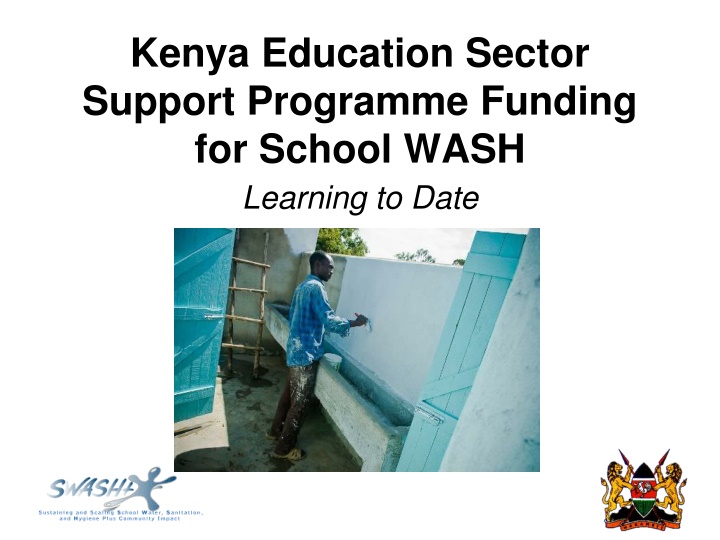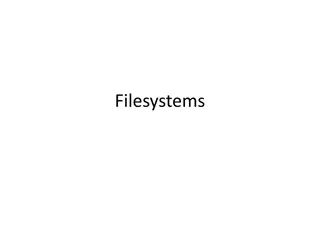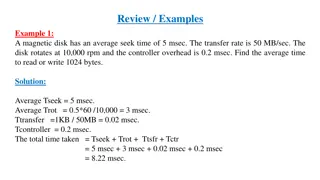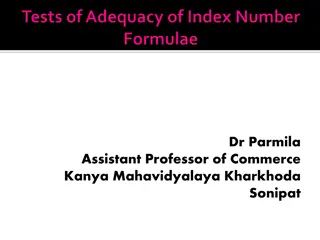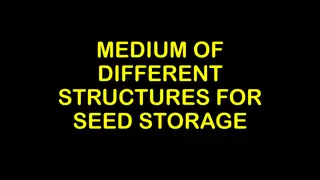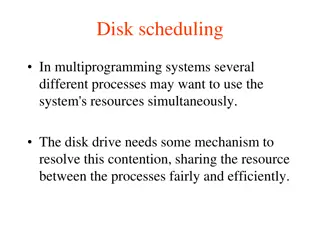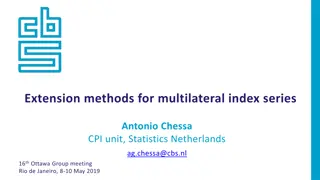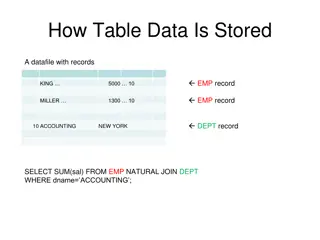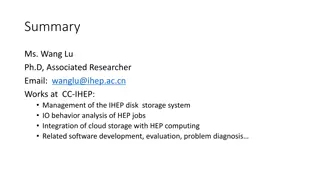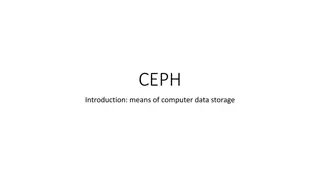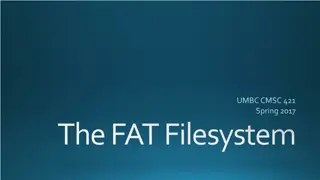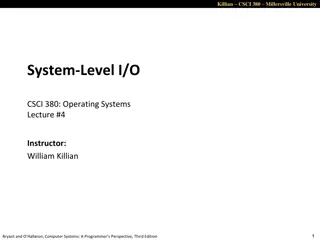Disk Storage Index Structures for Files Lecture 12
The lecture covers disk storage devices, the basic unit of data storage, and preferred secondary storage devices in computer systems. It explains how data is represented in bits and grouped into bytes on magnetic disk surfaces. Disk organization into tracks and sectors is discussed, along with the process of transferring disk blocks to main memory. The movement of read-write heads and the addressing system for physical disk blocks are also explained. Time-consuming aspects of reading or writing disk blocks are highlighted, along with the use of double buffering to improve transfer speeds.
Download Presentation

Please find below an Image/Link to download the presentation.
The content on the website is provided AS IS for your information and personal use only. It may not be sold, licensed, or shared on other websites without obtaining consent from the author.If you encounter any issues during the download, it is possible that the publisher has removed the file from their server.
You are allowed to download the files provided on this website for personal or commercial use, subject to the condition that they are used lawfully. All files are the property of their respective owners.
The content on the website is provided AS IS for your information and personal use only. It may not be sold, licensed, or shared on other websites without obtaining consent from the author.
E N D
Presentation Transcript
Kenya Education Sector Support Programme Funding for School WASH Learning to Date
Guiding question Given that ...direct funding of schools for school improvements is the national policy how can we make it better?
Sources of Data 3-year SWASH+ sustainability study (185 schools) Monitoring and interviews in 8 schools funded by KESSP or receiving official latrine designs from SWASH+ in 2009 SWASH+ experience in direct funding of 18 schools in 2009 using the KESSP process Roles and responsibilities assessment conducted across three districts in 2010 Review of school WASH budgets and needs in 20 schools in 2010
Areas of Examination 1. School-level budgets 2. Monitoring systems 3. Roles and responsibilities of actors
Learning on school WASH sustainability Handwashing 100% 97% 96% Proportion of schools 80% Has HW containers 77% 70% 68% 60% Has water in HW containers 55% 40% Has provided soap today 36% 20% 21% 8% 0% Year 1 Year 2 Year 3
Sustainability 111 Intervention Schools (Incomplete data on 4 schools) Potential Barriers: Broken containers? Broken taps? No Supply Chain? Not a priority? HW containers: 75 schools (68% of all schools) Potential Barriers: No water source? Water not put in containers? Not a priority? Water available: 61 schools (55% of all schools) Potential Barriers: Stolen? Never purchased? No Budget? Not a priority? Soap Available: 9 schools (8% of all schools)
School Budgets for Yearly WASH Services Record-keeping is spotty and inconsistent, but Yearly allocations are almost certainly insufficient Schools vary widely in how much they prioritize WASH
School Budgets for Yearly WASH Services Record-keeping is spotty and inconsistent, but Yearly allocations are clearly insufficient Schools vary widely in how much they prioritize WASH From a survey of 20 schools: Head teachers claim to have spent an average of 103 Ksh per pupil for WASH costs (Almost a third of the entire FPE allocation of 370 Ksh per pupil per year). 60% of this to obtain water (hygiene and sanitation expenditures are minimal). The range of amounts reported is large, between 2 and 263 Ksh per pupil, indicating that there is no consistent practice.
What Schools Actually Receive (Ksh/pupil/year) Total per term Total per year FPE Capitation Support Wages (Askaris, cooks etc) KES 55.00 KES 110.00 Repairs, Maintenance and Improvements KES 60.00 KES 120.00 Activity (Drama and sports festivals etc) KES 22.00 KES 44.00 Quality Assurance (School based exaninations) KES 15.00 KES 30.00 Local transport and travelling KES 15.00 KES 30.00 Electricity, water and conservancy KES 5.00 KES 10.00 Telephone/PO Box rental/Postage KES 10.00 KES 20.00 Contingency KES 3.00 KES 6.00 Total KES 185.00 KES 370.00 ..and other decentralized grants (e.g. CDF or center of excellence).
Monitoring for WASH Services What s Working Infrastructure outcomes are reasonable Most schools are getting the basic infrastructure work done Despite some issues, schools are generally satisfied with the quality of the resulting infrastructure One visit from DEO s office generally happens
Monitoring for WASH Services What s not working It s all about infrastructure no focus on behaviors like hygiene or inexpensive inputs like soap or water treatment Little involvement beyond (untimely) monitoring by the Ministry of Education (e.g. no MOPHS) DICT not budgeting for monitoring Schools receive no report or feedback No consistent monitoring tool used Relevant WASH data not aggregated at higher level and shared with relevant Ministries Policing rather than supportive (nat l and DICT)
Roles and Responsibilities District-level No clear understanding of the process among officers, even within a given district Other ministries uninvolved (e.g. MOPHS) Uncritical approval of SIDPs, particularly with respect to non-infrastructure planning Lack of budgeting
Roles and Responsibilities School Level SMC and SIC conflict a constant theme SMCs and SICs members unable to accurately recall the process that they went through Confusion because manual either doesn t make it to SMCs/SICs or because some members can only read the local language Low capacity of fundis/contractors, particularly financial Significant management burden on head teachers
Core Recommendations Overall: Move from an infrastructure to a service provision approach. (e.g. latrine ratio less important than cleanliness and latrines without hand washing can hurt) Further decentralize monitoring and provide a budget for it initial experience with decentralized monitoring shows promise Ensure that monitoring systems are integrated, consistent, supportive and informative
Core Recommendations (cont.) Add non up-front costs for schools into yearly FPE allocations minimum of 33 Ksh/year Establish a system for enhanced accountability that goes both up and down (e.g. a simple scoring system that creates space for discussion) Aggressive training at locational/zonal and school levels (teachers, fundis, line ministries)
